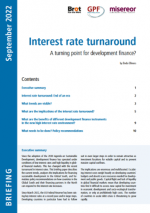New Release: Interest rate turnaround. A turning point for development finance?
Published on Thu, 2022-09-15 19:54
Since the adoption of the 2030 Agenda on Sustainable Development, development finance has operated under conditions of low interest rates and high liquidity in global financial markets. This has changed with the recent turnaround in interest rates. The briefing paper Interest rate turnaround. A turning point for development finance? by Bodo Ellmers, describes the current trends, analyzes the implications for financing sustainable development in the Global South, and formulates policy recommendations on how countries in the Global South and their financing partners in the North can respond to the interest rate increases. Since March 2022, the US Federal Reserve has been raising key interest rates at a record pace and in large steps. Developing countries in particular have had to follow suit in even larger steps in order to remain attractive as investment locations for volatile capital and to prevent massive capital outflows. The implications are enormous and multifaceted. Escalating interest costs weigh heavily on developing countries’ budgets and absorb scarce resources needed for development and public goods. Capital flight and lack of liquidity in global financial markets mean that developing countries find it difficult to access new capital for investment in economic development and socio-ecological transformation, or only at prohibitively high costs. The number of countries in acute debt crises is threatening to grow rapidly. The optimal mix of instruments in development finance changes with the level of interest rates. The turnaround of interest rates is also a gamechanger for development finance. It requires a fundamental policy shift. As interest rates rise, using private financing at market conditions is rational and affordable for fewer countries and for fewer purposes. At the same time, financing channels such as domestic financing from tax revenues or external financing from Official Development Assistance (ODA) grants become more important, as these are not dependent on interest rate levels. The interest rate turnaround exacerbates the humanitarian emergency in the Global South, where populations have been hit hard by multiple energy, food, climate, and coronavirus crises. In the short term, the international community can provide liquidity to the Global South, for example, through a new issue of International Monetary Fund (IMF) Special Drawing Rights. Relief packages also need to be put in place in developing countries to protect vulnerable groups, and investment in sustainable development still needs to be scaled up under difficult conditions. Fair and effective taxation, debt relief and ODA grants can increase the fiscal space for this. Interest rate turnaround
|


